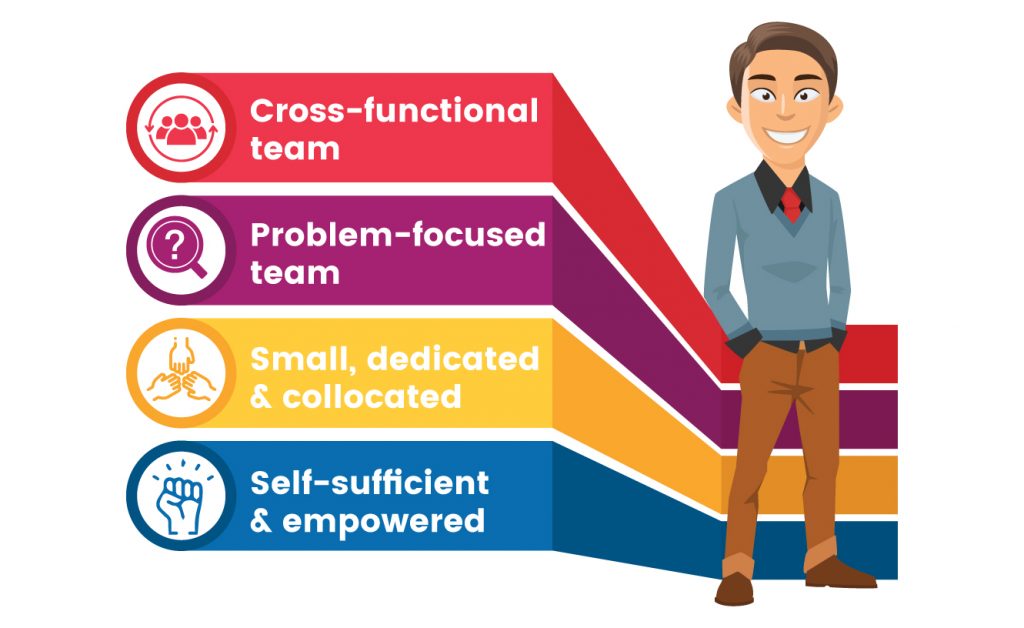What is Lean UX? Insights on its Principles
Simple principles of Lean UX are at the heart of the core set. We can also consider these principles as a framework.
- Team Organization
- Guide Culture
Wow, this sounds similar to the Scrum framework or Agile Development?
Yes, that’s absolutely correct.
Ultimately if we are able to put these principles to work, we will find that we can harness our team’s culture. These will help us to build a product design organization that is more collaborative, more cross-functional, and a better fit for today’s Agile reality.
So what is in the world of Lean UX?
Overall, it’s a combination of Lean Startup & Agile Development. It means the practice of bringing together a product to light faster, in a collaborative, cross-functional way.
As in Scrum practice, we work in the continuous feedback loop of iterations via customers feedback at the end of every sprint review cycle.
Now, let’s discuss each principle and how it works
- Team Organization
- Guide Culture
Team Organization
- Cross-functional team
- Small, dedicated & collocated
- Self-sufficient & empowered
- Problem-focused team
- Cross-functional team
- Cross-functional team
These teams are a combination of different roles to create your products like developers, managers, designers, content writers, marketing, QA, and many more, who make up a part of LEAN UX teams. Basically, it’s collaboration & continuous involvement or communication between each other and this goes on from day one of the project until the end of the engagement. Sound similar to Agile Methodology?
Well, yes, it is similar! What is its purpose?
In a waterfall model, each team member works in their way, and the final product outcomes will be different.For example: In situational Management, the Project Manager will draft the features lists and hand it over to the design team, Now the design team will create the design and pass it to the development team. This cycle comes to an end when QA is done and is releasable to the product stage.
Now, during this process, there will be no feedback iteration or market analysis during the project development cycle. And due to this, project outcomes will differ from what a customer or end-user actually needs.
So, to avoid these pit holes, LEAN UX & Agile will help the team to share information informally, which creates collaboration earlier in the process & drives higher team efficiency. - Small, dedicated & collocated
The team size can be small, with no more than 10 members. They are dedicated to only one project and working at the same location.
How will it help?
Small team benefits are,
- Communication
- Focus
- Camaraderie
It will help the team track status, changes, and new learning. Dedicating your team to one project keeps team members focused on the same priorities all the time and eliminates dependencies on other teams. Having the team all in one place allows the relationship to grow between them.
- Self-sufficient & empowered
Without external dependencies, give all the capabilities or freedom to operate to your team. We have to ensure that at their disposal they have enough tools to create and release software/products. Also, give openness & courage to them to figure out how to solve the problems.
Why do it?
It increases efficiency, freedom & learning curve amplifies. The team can interact with customers directly in order to get the freedom they need to create effective solutions. -
Problem-focused teams
A team has been given a problem related to business, rather than a set of features to create, which is also one of the core values of the Agile manifesto and LEAN UXHow will it help?
Instead of providing a set of features to the team, give business problems that can unleash their potential for problem-solving. By doing this they will interact with each other and come up with better MVP solutions for the product. This will also be helpful for the team to stay on the same page and be aware of the project status and features.
Principles to Guide Culture
Adopting Lean UX means adopting a culture of learning and curiosity. Let’s discuss how it will help the team.
There are six parameters to discover.
- Moving from doubt to certainty
- Outcomes, not output
- Removing waste
- Shared understanding
- No rock stars, gurus, or ninjas
- Permission to fail

- Moving from doubt to certainty
Software development is complex and unpredictable. Because of this, Lean UX begins with the idea that everything is an assumption until we prove otherwise. As we work, we gain clarity. Sometimes, these assumptions are easy to spot, sometimes we don’t see them until it’s too late to eliminate the risk of investing a lot of time and effort in work that’s based on bad assumptions. We begin by validating our assumptions.
- Outcome matters, not output
Features and services are outputs. The goals are meant to achieve our outcomes. In Lean UX, the team is trying above all to create a meaningful and measurable change in customer behavior: an outcome. Lean UX measures progress in terms of explicitly defined outcomes.
- Removing waste
One of the core tenets of Lean manufacturing is the removal of anything that doesn’t lead to the ultimate goal. Hence, anything that doesn’t contribute to that is considered a waste and should be removed from the team’s process. Thinking in terms of value creation and waste removal can help the team to keep their laser focus where it belongs. - Shared Understanding
This can be built over time as the team works together. In addition, it reduces the team’s dependencies on second-hand reports and detailed documents to continue its work.
- No rock stars, Gurus, or ninjas
Here we talked about team-based mentality. Everyone is equally contributed and there are no stars. Rather than focus on star performers, Lean UX seeks team cohesion and collaboration. - Permission to fail
We have to experiment with new ideas to get the best solutions for business problems. Most of these ideas will fail. And that’s how permission to fail means that the team has a safe environment to experiment.
In Conclusion
All in all, these are the foundations of Lean UX. Once you understand these principles, they will be easy to apply within the team and as well in the organization. In the beginning, the process can be a little difficult to establish but as time goes by it will give fruitful results and give the best solutions for not only the team but the business problem as well.

 +91 9638710389
+91 9638710389 








